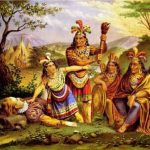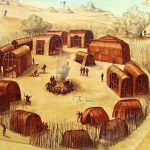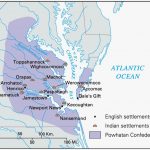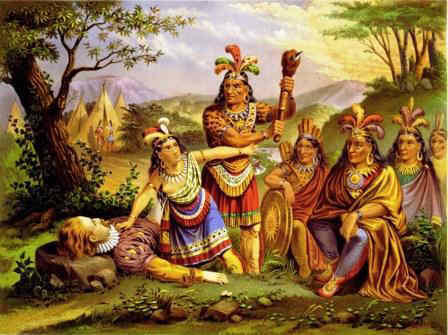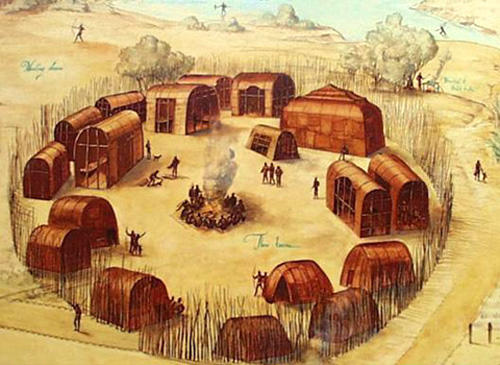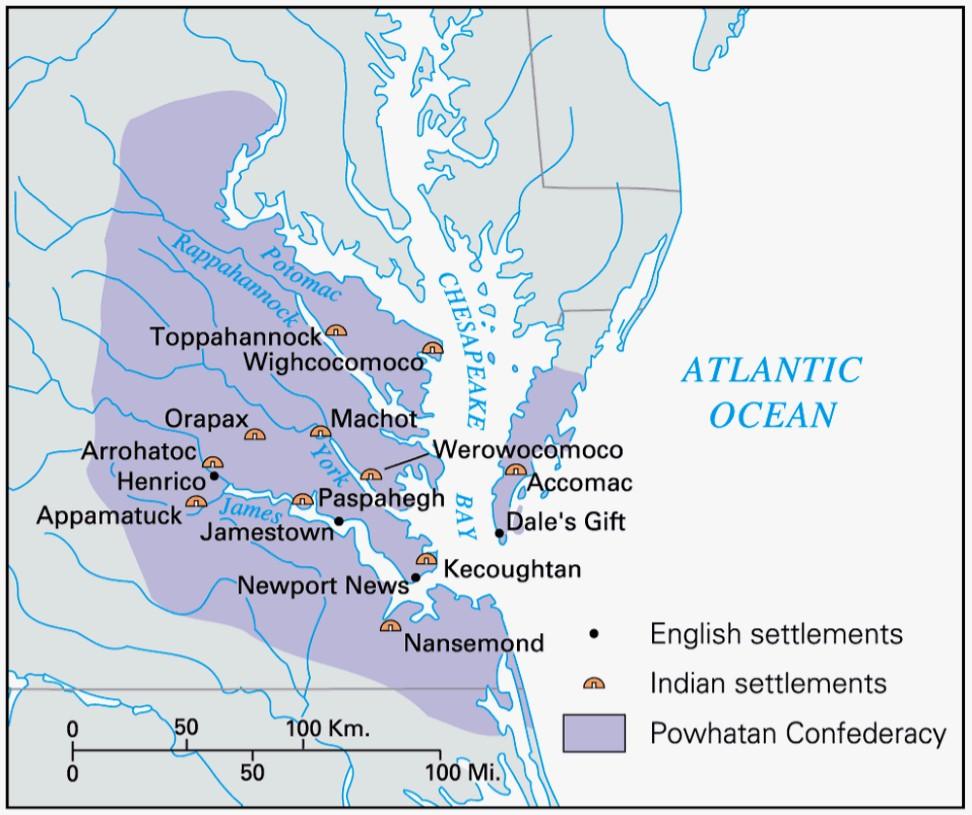By the time the English established their colony at Jamestown in 1607, the native villages under the chief Powhatan numbered around thirty. These
communities ranged across much of eastern Virginia.
Whether or not a confederacy existed under Powhatan’s leadership has been a matter of contentious debate within the scholarly community. Some
scholars insist that to use the term confederacy is improper, since Powhatan gained control of Virginia through violence and intimidation. Others argue that
the term does not imply willing acceptance of Powhatan’s rule, but rather that the villages were linked and their residents often acted in concert. Apart
from the squabble over terminology, it is more important to consider Powhatan culture and political structures and how these forces shaped the
colonization of early Virginia.
Powhatan born between 1540 and 1550 inherited the position of paramount chief and quickly expanded the territory under his control throughout the
late sixteenth and early seventeenth centuries. Although he expanded his territory by conquest, his position was hardly analogous to that held by Queen
Elizabeth I in England. He was not a monarch and did not have subjects in the traditional sense.
Powhatan’s territory, Tsenacommacah, was split up into various districts. The districts were broken down into individual villages and other types of
settlements. Each village had its own werowance, or chief, often the leader of the tribe before Powhatan arrived, who served at Powhatan’s discretion.
Powhatan also placed relatives because of matrilineal inheritance these were more often siblings than children in positions of power throughout his
growing empire.
The nature of Powhatan society prevented the chief from making all but the largest strategic decisions in the governance of his people. Most affairs were
handled at the local level by officials with tributary ties to Powhatan. Powhatan could also not act independently of the advice of his priests and councilors.
Chiefs did play large roles in Powhatan ceremonial life, presiding over the rituals that transformed boys into men and celebrated the ripening of the first of
the year’s corn. The chiefs’ prominence in events like these, when they were honored by their wives, priests, and ordinary people, probably led the
English who met them to inflate their role in their peoples’ everyday lives. Chiefs also acted as stewards for tribal lands and fulfilled other political duties.
When the English arrived at Jamestown, Powhatan’s empire in eastern Virginia was at the height of its power. The English had superior technology and
were every bit as expansionist and nationalist as the Powhatan. They also had fewer people and a propensity for dying of starvation and disease.
Moderate estimates place the Powhatan population at the time between 12,000 and 14,000; Powhatan tried to incorporate the English into his empire at
the same time the English tried to expand theirs into Virginia.
Powhatan went about this task in a culturally specific way. His forces captured John Smith and took him on a tour of Powhatan territory. Smith met
various native military and political leaders from throughout eastern Virginia, including Powhatan and his brother Opechancanough. While Smith’s
perceptions were colored by his Englishness, his writings show him to be a keen observer of Powhatan society.
Smith’s life was threatened three times, finally and most famously by Powhatan. In this instance, one of Powhatan’s daughters Pocahontas intervened.
It is unclear whether the danger facing Smith was real or ritual, but most scholars believe he was the unknowing party to a ceremony through which
Jamestown became another village tributary to Powhatan.
The English did not behave like subjects of Powhatan, however. They acted aggressively, pressing their Native American neighbors for food, fur, skins,
and territory. As a result, the English and the Powhatan fought each other sporadically from 1610 to 1614. More destructive attacks, led by
Opechancanough, occurred in 1622 and 1644.
The end of the Powhatan Confederacy is hard to place. Powhatan himself retired from public life in 1617 and died a year later. The paramount chieftancy
was no longer in place as of 1650. Algonquin resistance to English colonization continued well into the seventeenth century, but white colonists overran
their settlements almost entirely in the 1676 fighting associated with Bacon’s Rebellion. By 1700, most Native Americans still remaining in Virginia lived on
reservation-type lands.
Matthew Jennings
See also: Jamestown; Native American-European Relations; Native Americans; Opechancanough; Powhatan; Virginia;
Virginia (Chronology).
Bibliography
Gleach, Frederic W. Powhatan’s World and Colonial Virginia: A Conflict of Cultures. Lincoln: University of Nebraska Press, 1997.
Rountree, Helen C., ed. Powhatan Foreign Relations, 15001722. Charlottesville: University Press of Virginia, 1993.
Rountree, Helen C., ed. The Powhatan Indians of Virginia: Their Traditional Culture. Norman: University of Oklahoma Press, 1989.
Powhatan Confederacy Photo Gallery
Maybe You Like Them Too
- Top 10 Islands You Can Buy
- Top 10 Underrated Asian Cities 2023
- Top 10 Reasons Upsizing Will Be a Huge Travel Trend
- Top 10 Scuba Diving Destinations
- The Best Cities To Visit in The World

